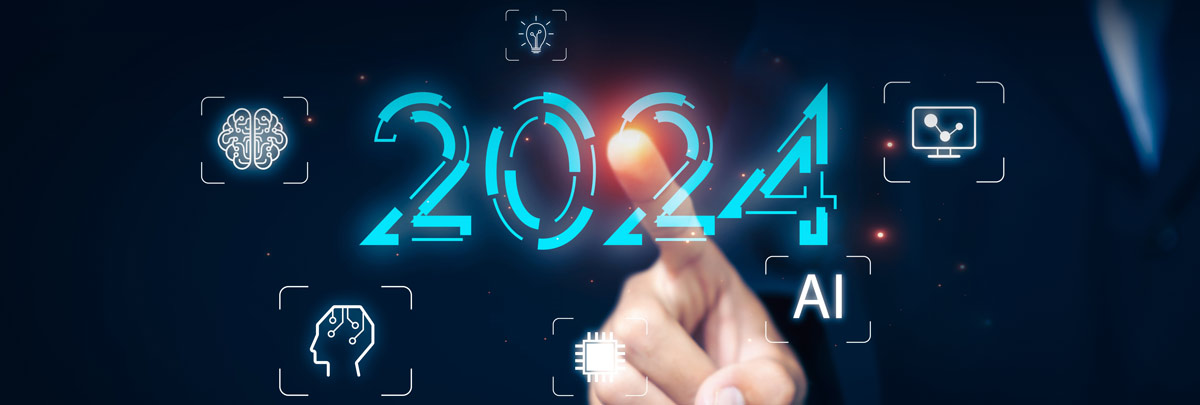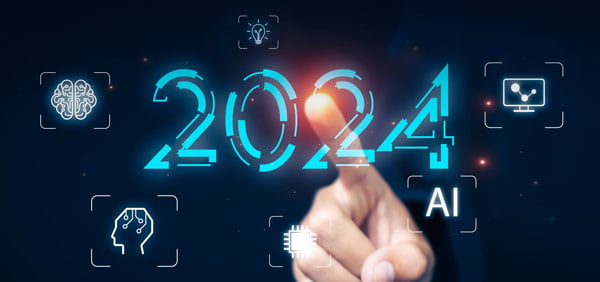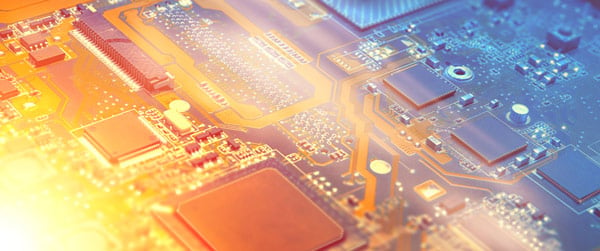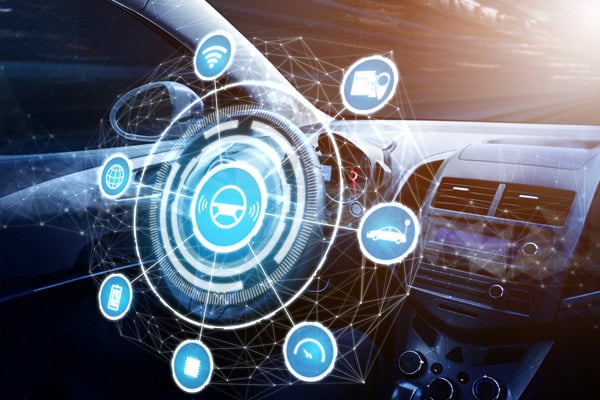
Transformative 2024 technology and software trends
- 6 minute read
-
Author: Mobica
2024 is fast approaching, but sometimes it can feel like technology trends are moving even faster. Given the pace of change surrounding software trends, it’s perhaps no surprise that 80% of CIOs report they are planning to increase spending on cyber and information security next year1.
Software innovations are at the very heart of the digital economy, and their impact can be especially felt in three critical industries: manufacturing, semiconductor and automotive.
What are the tech opportunities to seize in these sectors in 2024? And how can you create new business opportunities, by leveraging these transformative 2024 technology trends?
Let’s explore automotive connectivity trends, semiconductor technology trends and manufacturing technology trends for next year.

Adopt a security-first approach in manufacturing
Industry 4.0 has made a remarkable impact on the global manufacturing industry in recent years - and will continue to do so. This is perhaps no surprise, with automation, AI and predictive maintenance becoming increasingly embedded. Generative AI, for instance, has the potential to dramatically boost productivity and sustainability efforts for the sector, with significant uptake this year alone. In one recent report, 78% of industrial manufacturing executives selected generative AI as the top emerging technology trend for the industry2.
Indeed, companies are realising that incremental changes are no longer enough to sustain long-term growth. Instead, innovation and digital transformation must be placed at the very heart of operations. So far, so much the same in 2024.
Yet, as this digital agenda becomes more and more adopted by smart factories, there’s now a need for greater balance between the industry-wide drive for digital transformation and cybersecurity. For instance, last year manufacturing was the most targeted sector for ransomware attacks for the second consecutive year3. And the disruption, cost and damage to brand reputation from cybersecurity threats will only grow exponentially.
Did you know?
Last year, manufacturing was the most targeted sector for ransomware attacks for the second consecutive year

As an example, significant strides continue to be made around quantum computing. And while this has the potential to unlock incredible value through optimisation for the manufacturing sector, quantum computing in and of itself is also becoming a critical cybersecurity concern. In the coming years, hackers will be able to use the power of quantum mechanics to crack encryptions that would currently take years to break, in mere minutes. For this reason, it is vital that resistance is built into your systems and resilience established across your processes.
As a manufacturer, consider the potential damage to your brand. From advanced persistent threats to targeted attacks on your supply chain, the top manufacturing technology trend is to adopt a security-first approach.
To achieve this, manufacturers will need to adopt a more holistic security framework. Key to this will be a ‘zero-trust’ model. This not only has the power to increase resilience, but leverage unique silicon chip features and secure microprocessor elements to bolster device security. Through the three pillars of prevention, detection and recovery, you have the chance to implement a strategy that priorities cyber resilience.
Interested in learning more about securing the connected future? Take a look here.
Power greater performance with custom system-on-chips
By 2025, the world will produce over 180 zettabytes of data?4 The amount of data the world generates was increasing at a steady rate before the global Covid-19 pandemic, but since then growth has accelerated fast. Whether it’s remote working, the digitalisation of existing processes, the ever-growing adoption of technology around the world, or the development of data-hungry innovations such as AI and machine learning, these complex workloads require strong computing power to support them.

As such, chip complexity continues to rise in the semiconductor industry. To realise improvements in compute performance going forward, a fundamental shift is needed.
The answer? Custom system-on-chips that embrace heterogeneous computing, the key semiconductor technology trend for 2024. These can be tailored to a company’s specific application requirements, provide greater control when integrating hardware and software, and deliver greater performance benefits and cost efficiencies.
Too often when designing a platform, you’ll face a tradeoff between the following…
The trilemma trade-off
A heterogenous approach overcomes this challenge, by breaking the links shown in the above visual.
It breaks the link between performance and flexibility, so systems can easily scale up to meet increased demands if required.
Then, by taking advantage of features such as smart scheduling, you can break the link between flexibility and cost, using as many processors for as many tasks as possible.
Finally, a flexible and scalable system will be more efficient and more cost-effective than a specific system responsible for managing multiple tasks.

World-renowned brands like Google and Amazon are already taking advantage of the vast efficiencies that a heterogeneous approach can offer. Amazon Web Services, for example, has developed and implemented its Graviton processor, a custom-designed, Arm-based chip. Meanwhile, Google continues to develop its C3 machine series, delivering more predictable and efficient compute, high performance storage and a programmable packet processing capability for low latency and accelerated, secure networking5.
In 2024, custom system-on-chips that embrace heterogeneous computing will make a marked difference for semiconductors. From reduced design costs and fewer testing requirements, to lower power consumption and better performance, there are real gains to be made from moving towards custom system-on-chips.
Keen to discover more?
Go the extra mile for a new kind of driving experience
In automotive, technology is mapping a transformative route towards revolution inside vehicles. AI-driven voice assistants and predictive analytics are creating increasingly personalised and intuitive in-cabin experiences. Meanwhile, intelligent LiDAR and radar sensors are improving autonomous driving and ADAS capabilities.
The rise of the open-source movement can be witnessed in automotive too, with companies continuing to relax their licensing across pioneering areas of technology, and thereby encourage greater adoption. Take Google Android, for example, which has fast-become almost the default operating system used within in-vehicle infotainment systems deployed by the automotive industry.

While a car’s worth was once determined by mechanical performance and exterior styling, today’s consumers are looking for vehicles that connect them with the world around them.
In a recent survey, the EPM (Experiences Per Mile) Advisory Council found that vehicle connectivity and adaptability play essential roles in today’s purchasing decisions6.
So, how can automotive OEMs get ahead in 2024? By placing the customer and their wants at the heart of the software-defined vehicle. This is the most important automotive connectivity trend for next year.
Firstly, consumers want their vehicles to help make their lives easier and more convenient. Does your vehicle enable on-the-go toll payments, or advanced parking reservations? Or is predictive maintenance offered, quickly identifying any possible issues and ensuring they’re remedied before becoming a more costly concern? These features help to save time and money for both the driver and passengers.
Secondly, they expect cars to come with built-in navigation tools. Most new cars provide live traffic updates and optimise recommended routes depending on real-time information, but what’s next? Navigation data will now be used by developers to enhance advanced driver-assistance systems and shape the autonomous vehicles sector.
Autonomous vehicles are expected to account for about 12% of global car registrations by 20307
Thirdly, consumers want to be entertained, with infotainment services providing the chance to deliver a truly enhanced driving experience - covering everything from social media to video streaming and gaming. Indeed, some gaming brands are viewing tomorrow’s cars as an opportunity to transform automobiles into real-life controllers. People will be able to use their dashboard screens, steering wheel and pedals to play games while inside their vehicles, bringing the gaming experience to life in a more immersive way.
Finally, consumers need to feel safe and secure. Does your new car feature a dashcam? ADAS functions like pedestrian detection and avoidance, lane departure warning and correction, or traffic sign recognition? With automatic emergency braking and blind spot detection systems also on the rise, the National Safety Council reports ADAS technologies have the potential to prevent 20,841 deaths a year - about 62 per cent of total traffic deaths8.
It’s also important to note that consumer preferences and use cases for connectivity and digital services must be monitored. For instance, a recent survey highlighted most consumers want flexible access to connectivity features9.
Eager to learn more about the vital software considerations you need to take into account for this new kind of driving experience? Download our complimentary e-guide.
Setting extraordinary tech trends
So, there you have it - the transformative technology trends to keep a close eye on during 2024
If you’d like to speak to one of our experts in more detail about these developments, please don’t hesitate to get in touch.
1 Gartner, ‘Gartner Survey of Over 2,400 CIOs Reveals that 45% of CIOs are Driving a Shift to Co-Ownership of Digital Leadership’, https://www.gartner.com/en/newsroom/press-releases/2023-10-17-gartner-survey-of-over-2400-cios-reveals-that-45-percent-of-cios-are-driving-a-shift-to-co-ownership-of-digital-leadership
2 KPMG, ‘Getting a head start with generative AI in industrial manufacturing’, https://mobica.com/newsandinsights/are-you-ready-to-unlock-the-potential-of-generative-ai-in-manufacturing-1
3 IBM, ‘Ransomware Persisted Despite Improved Detection in 2022’, https://newsroom.ibm.com/2023-02-22-IBM-Report-Ransomware-Persisted-Despite-Improved-Detection-in-2022
4 TechJury, ‘25+ Big Data Statistics for 2023’, https://techjury.net/blog/big-data-statistics/
5 Google, ‘The next wave of Google cloud infrastructure innovation: New C3 VM and Hyperdisk’, https://cloud.google.com/blog/products/compute/introducing-c3-machines-with-googles-custom-intel-ipu
6 WardsAuto, ‘Measuring the future of consumers’ automotive needs’, https://www.wardsauto.com/vehicles/measuring-future-consumers-automotive-needs
7 Statista, ‘Projected autonomous vehicle registration share worldwide between 2021 and 2030’, https://www.statista.com/statistics/875080/av-market-penetration-worldwide-forecast/
8 National Safety Council, ‘Advance Driver Assistance Systems’, https://injuryfacts.nsc.org/motor-vehicle/occupant-protection/advanced-driver-assistance-systems/data-details/
9 McKinsey & Company, ‘How do consumers perceive in-car connectivity and digital services?’, https://www.mckinsey.com/industries/automotive-and-assembly/our-insights/how-do-consumers-perceive-in-car-connectivity-and-digital-services